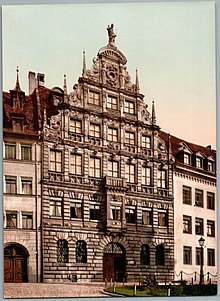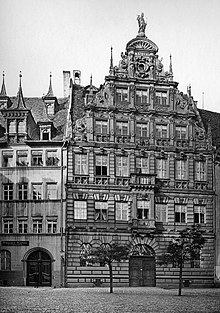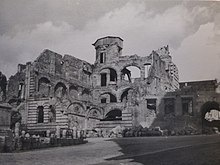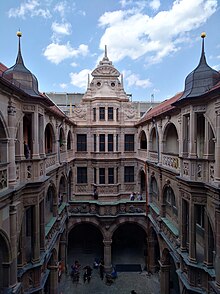
Nuremberg is the second-largest city of the German state of Bavaria after its capital Munich, and its 518,370 (2019) inhabitants make it the 14th-largest city in Germany. On the Pegnitz River and the Rhine–Main–Danube Canal, it lies in the Bavarian administrative region of Middle Franconia, and is the largest city and the unofficial capital of Franconia. Nuremberg forms with the neighbouring cities of Fürth, Erlangen and Schwabach a continuous conurbation with a total population of 800,376 (2019), which is the heart of the urban area region with around 1.4 million inhabitants, while the larger Nuremberg Metropolitan Region has approximately 3.6 million inhabitants. The city lies about 170 kilometres (110 mi) north of Munich. It is the largest city in the East Franconian dialect area.
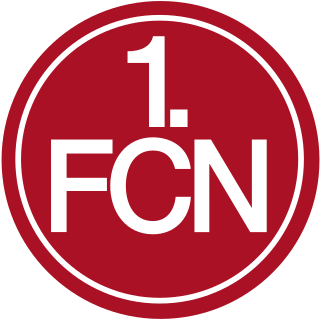
1. Fußball-Club Nürnberg Verein für Leibesübungen e. V., often called 1. FC Nürnberg or simply Nürnberg, is a German association football club in Nuremberg, Bavaria, who currently compete in the 2. Bundesliga. Founded in 1900, the club initially competed in the Southern German championship, winning their first title in 1916. Their first German championship was won in 1920. Before the inauguration of the Bundesliga in 1963, 1.FCN won a further 11 regional championships, including the Oberliga Süd formed in 1945, and were German champions another seven times. The club has won the Bundesliga once and the DFB-Pokal four times.

Nuremberg Castle is a group of medieval fortified buildings on a sandstone ridge dominating the historical center of Nuremberg in Bavaria, Germany.

In Germany, Luxembourg and Austria, the Regional-Express is a type of regional train. It is similar to a semi-fast train, with average speed at about 70–90 km/h as it calls at fewer stations than Regionalbahn or S-Bahn trains, but stops more often than InterCity services.

Cadolzburg is a municipality in the Middle Franconian district of Fürth, in Bavaria, Germany. It is situated 11 km (6.8 mi) west of Fürth. Its name derives from its central castle, first being mentioned in the year 1157.
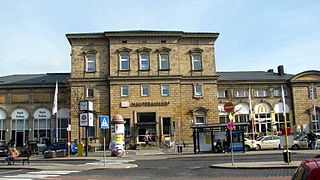
Bayreuth Hauptbahnhof is the main railway station in the German town of Bayreuth, in northern Bavaria.
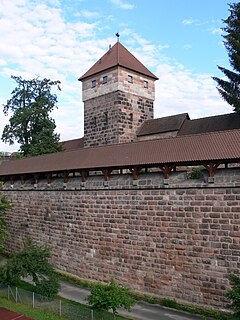
The city walls are the medieval defensive mechanism surrounding the old city of Nuremberg, Germany. Construction started in the 12th Century and ended officially in the 16th Century. They measured 5 kilometers around the old town. The Nuremberg Castle together with the city wall is meant to be one of Europe's most considerable medieval defensive systems.

The Nuremberg-Bamberg line is a German railway connecting the Bavarian city of Nuremberg with Bamberg via Fürth, Erlangen, Forchheim. It is part of the northern section of the Ludwig South-North Railway. It runs along the Regnitz Valley and is one of the important German transport routes. Since 2010 line S1 of the Nuremberg S-Bahn uses the entirety of the line from Nuremberg to Bamberg.

Neues Museum Nürnberg (NMN) is a museum for modern and contemporary art and design in Nuremberg.

Sep Ruf was a German architect and designer strongly associated with the Bauhaus group. He was one of the representatives of modern architecture in Germany after World War II. His elegant buildings received high credits in Germany and Europe and his German pavilion of the Expo 58 in Brussels, built together with Egon Eiermann, achieved worldwide recognition. He attended the Interbau 1957 in Berlin-Hansaviertel and was one of the three architects who had the top secret order to create the governmental buildings in the new capital city of the Federal Republic of Germany, Bonn. His best known building was the residence for the Federal Chancellor of the Federal Republic of Germany, built for Ludwig Erhard, the so-called Chancellor's Bungalow.
Nürnberger Versicherung is a German insurance company headquartered in Nuremberg. The group operates in the life, private health, property/casualty and auto insurance segments as well as in the financial services sector, primarily in Germany and Austria.
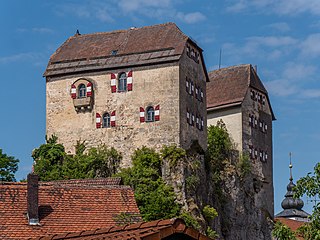
Hiltpoltstein Castle was originally a high mediaeval aristocratic castle dating to the 11th or 12th century. It stands in the centre of the market village of Markt Hiltpoltstein in the Upper Franconian county of Forchheim in the south German state of Bavaria. Its present appearance as a triple-winged building goes back to renovations carried out at the end of the 16th century.
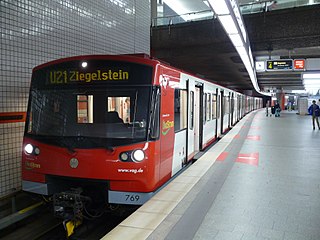
The VAG Class DT3 is an electric multiple unit (EMU) train type operated by the Verkehrs-Aktiengesellschaft Nürnberg on the Nuremberg U-Bahn system. It is the first type of rolling stock on the Nuremberg U-Bahn that has gangways between the individual cars.
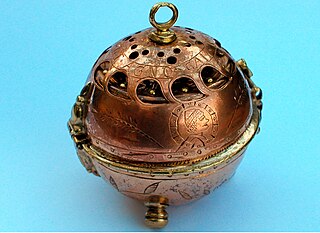
The Watch 1505 is the world's first watch. It was crafted by the German inventor, locksmith and watchmaker Peter Henlein from Nuremberg, during the year 1505, in the early German Renaissance period, as part of the Northern Renaissance. However, other German clockmakers were creating miniature timepieces during this period, and there is no definite evidence Henlein was the first. It is the oldest watch in the world that still works. The watch is a small fire-gilded copper sphere, an oriental pomander, and combines German engineering with Oriental influences. In 1987, the watch reappeared at an antiques and flea market in London. The initial price estimation for this watch is between 50 and 80 million dollars.

Nürnberg-Dutzendteich station is a railway station in Nuremberg, Bavaria, Germany. It is located on the Nuremberg–Feucht line of Deutsche Bahn. It is served by the S2 of the Nuremberg S-Bahn and line 6 of the Nuremberg tramway system.

The bombing of Nuremberg was a series of air raids carried out by allied forces of the Royal Air Force (RAF) and the United States Army Air Forces (USAAF) that caused heavy damage throughout the city from 1940 through 1945.

The Old Town Friends Nuremberg are an association that supports the preservation and restoration of the existing historical old town houses and other architectural monuments in Nuremberg that are worth preserving.

The Toplerhaus was an important Renaissance town house in the German city of Nuremberg. It was named after the patrician family Topler and was among the most elaborate of the late Renaissance residencies in the city. It was destroyed in a bombing raid in World War II.

The Nuremberg City Hall is located in the old town of Nuremberg, just east of the choir of the Sebalduskirche. It is part of the Historic Mile of Nuremberg as one of the city's sights. The imposing Renaissance building by architect Jakob Wolff the Younger (1571–1620) was severely damaged during World War II and had to be largely rebuilt in the 1950s. In the process, the structure was shortened by two window axes on the north side. On the south side is a core Gothic Saalbau, which Albrecht Dürer designed. The Lochgefängnisse, located in the basement, are considered a tourist attraction, as is the Beautiful Fountain, located directly in front of the New City Hall, designed by Kurt Schneckendorf in 1951 and built from 1954 to 1956. This building replaced the row of houses between the Old Town Hall and the Hauptmarkt, which had been destroyed during the war.

The Nassauer Haus or Schlüsselfeldersche Stiftungshaus in Nuremberg is a medieval residential tower made of so-called red castle sandstone. Although originally built in Romanesque style, after several reconstructions the house is still characterized by Gothic style elements. It is the last still existing residential tower in Nuremberg.

